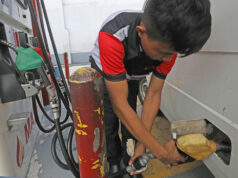Current account deficit seen as ‘manageable’ — NEDA’s Balisacan

THE current account deficit will be “manageable” even with imports rising as the government ramps up its infrastructure projects, National Economic and Development Authority (NEDA) Secretary Arsenio M. Balisacan said.
In a forum organized by Nomura Holdings, Inc. last week, Mr. Balisacan said other sources of foreign exchange may offset the impact of the likely rise in capital goods imports on the current account.
“We do think that the implications of infrastructure spending on the current account are manageable,” Mr. Balisacan said.
The central bank estimates the current account deficit at $5.8 billion in the third quarter of 2022, widening from the year-earlier deficit of $974 million, due to the widening trade in goods deficit.
The current account is expected to end 2022 at a deficit of $20.5 billion, equivalent to 5.1% of gross domestic product (GDP), before narrowing to $19.9 billion (4.7% of GDP) this year.
Mr. Balisacan said the government is pushing to further develop tourism and the business process outsourcing (BPO) industry. It is also looking to increase the value-added of manufactured goods.
“BPOs will continue to be a major source of foreign exchange, (so) we’re adding more value to our BPOs by bringing in the creative industries and linking that part of the service sector with our manufacturing,” he said.
He added that the government will need to increase agricultural productivity to reduce import demand if it hopes to mitigate the current account deficit.
“If you increase local production in an efficient manner, then that could save us a lot of resources, (specifically) foreign exchange resources for the imports,” he said.
The trade deficit widened to a five-month high in January after exports contracted to their lowest in over two years, while imports posted growth after two months of declines.
The Philippine Statistics Authority reported that merchandise exports declined 13.5% year on year to $5.23 billion in January, the sharpest drop in 32 months.
Merchandise imports rose 3.9% year on year to $10.97 billion in January. This brought the January trade deficit to $5.74 billion, widening from the $4.50 billion deficit in December and the year-earlier deficit of $4.51 billion.
Mr. Balisacan also projects that remittances from overseas Filipino workers to remain robust and support the balance of payments.
“Those remittances are expected to remain strong even as our policy is to create quality jobs here so Filipinos would not need to be forced to take jobs outside the country,” Mr. Balisacan said.
“Nonetheless, in the medium term, we think that (some) inflows will continue to be robust,” he added.
The central bank reported record cash remittances in 2022 of $32.54 billion, up 3.6%, exceeding the previous record set in 2021.
The central bank expects remittances to grow 4% this year. — Keisha B. Ta-asan



